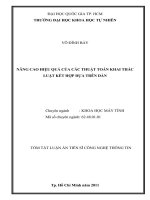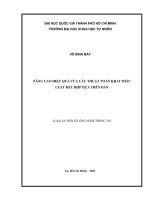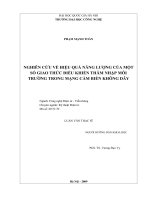Nâng cao hiệu quả truyền dữ liệu trong mạng cảm biến không dây dựa trên tương quan dữ liệu (Luận án tiến sĩ)
Bạn đang xem bản rút gọn của tài liệu. Xem và tải ngay bản đầy đủ của tài liệu tại đây (301.74 KB, 140 trang )
MINISTRY OF EDUCATION AND TRAINING
HANOI UNIVERSITY OF SCIENCE AND TECHNOLOGY
Nguyen Thi Thanh Nga
EFFICIENT DATA COMMUNICATION FOR WIRELESS SENSOR NETWORK
BASED ON DATA CORRELATION
Major: Computer Engineering
Code No.: 9480106
COMPUTER ENGINEERING DISSERTATION
SUPERVISORS:
1. Dr. Nguyen Kim Khanh
2. Assoc. Prof. Ngo Hong Son
Hanoi - 2018
COMMITMENT
I assure that this is my own research. All the data and results in the thesis are
completely true, were agreed to use in this thesis by co-authors. This research hasn’t
been published by other authors than me.
Hanoi, 17th Decemberber 2018
SUPERVISORS
AUTHOR
Dr. Nguyen Kim Khanh
Nguyen Thi Thanh Nga
Assoc. Prof. Ngo Hong Son
2
ACKNOWLEDGMENTS
This Ph.D. thesis has been carried out at the Department of Computer
Engineering, School of Information and Communication Technology, Hanoi
University of Science and Technology. The research has been completed under
supervisions of Dr. Nguyen Kim Khanh and Associate Prof. Dr. Ngo Hong Son.
Firstly, I would like to express my sincere gratitude to my advisors Dr. Nguyen
Kim Khanh and Associate Prof. Dr. Ngo Hong Son for their continuous support of
my Ph.D. study and related research, for their patience, motivation, and immense
knowledge. Their valuable guidance, unceasing encouragement and supports have
helped me during all the time of research and writing out of this thesis.
Besides my advisors, I would like to thank all my colleagues in the Department
of Computer Engineering for their insightful comments, encouragement and for the
hard questions which incented me to widen my research from various perspectives. I
would like to express my appreciation to Prof. Dr. Trinh Van Loan for his time and
patient helping me to correct the whole thesis as well as value comments during the
process of pursuing my doctorate degree.
I want to thank all my colleagues in the School of Information and
Communication Technology, for their supports and helps in my work.
I gratefully acknowledge the receipt of grants from 911 project of Ministry of
Education and Training which enabled me to carry out this research.
Finally, I would like to thank my family, my sisters, my father and mother, my
husband and two children for their endless love, encouraging and unconditional
supporting me continuously and throughout writing this thesis.
Nguyen Thi Thanh Nga
3
TABLE OF CONTENT
COMMITMENT ...................................................................................................... 2
ACKNOWLEDGMENTS........................................................................................ 3
TABLE OF CONTENT ........................................................................................... 4
LIST OF ABBREVIATIONS.................................................................................. 7
LIST OF FIGURES.................................................................................................. 8
LIST OF TABLES.................................................................................................. 11
PREFACE ............................................................................................................... 13
1
INTRODUCTION........................................................................................... 16
Overviews................................................................................................. 16
Energy conservation in WSNs.................................................................. 19
1.2.1
Radio optimization ............................................................................... 19
1.2.2
Sleep/wake-up schemes ....................................................................... 20
1.2.3
Energy efficient routing ....................................................................... 20
1.2.4
Data reduction ...................................................................................... 21
1.2.5
Charging solution ................................................................................. 22
Data correlation and energy conservation in WSNs ................................ 23
Problem statements and contributions...................................................... 24
2
CORRELATION IN WIRELESS SENSOR NETWORK.......................... 25
Correlation model survey ......................................................................... 25
Information entropy theory....................................................................... 31
2.2.1
Overview .............................................................................................. 31
2.2.2
Entropy concept ................................................................................... 32
2.2.3
Joint entropy......................................................................................... 32
Correlation and entropy............................................................................ 33
2.3.1
Correlation of two variables................................................................. 33
2.3.1.1 Mutual information ............................................................. 33
2.3.1.2 Entropy correlation coefficient ........................................... 34
4
2.3.2
Correlation of more than two variables................................................ 36
Conclusions .............................................................................................. 38
3
ENTROPY-BASED CORRELATION CLUSTERING.............................. 39
Joint entropy estimation ........................................................................... 39
3.1.1
Determining the upper bound of joint entropy..................................... 39
3.1.2
Determining the lower bound of joint entropy..................................... 42
3.1.3
Validating entropy estimation .............................................................. 44
Correlation region and correlation clustering algorithm .......................... 47
3.2.1
Estimated joint entropy and correlation ............................................... 47
3.2.2
Correlation region definition................................................................ 50
3.2.3
Correlation clustering algorithm .......................................................... 52
3.2.4
Validation ............................................................................................. 54
Conclusions .............................................................................................. 56
4
ENTROPY CORRELATION BASED DATA AGGREGATIONS ........... 57
Compression aggregation ......................................................................... 57
4.1.1
Comparison of compression schemes .................................................. 57
4.1.2
Compression based routing scheme in a correlated region.................. 60
4.1.2.1 1-D analysis ........................................................................ 61
4.1.2.2 2-D analysis ........................................................................ 65
4.1.2.3 General topology model analysis........................................ 69
4.1.3
Optimal routing scheme in correlation networks................................. 71
Representative aggregation ...................................................................... 72
4.2.1
Distortion function ............................................................................... 72
4.2.2
Number of representative nodes........................................................... 73
4.2.3
Representative node selection .............................................................. 76
4.2.4
Practical validation............................................................................... 77
Conclusions .............................................................................................. 80
5
5 ENTROPY CORRELATION BASED DATA AGGREGATION
PROTOCOL (ECODA) ......................................................................................... 82
Network model ......................................................................................... 82
Radio model.............................................................................................. 83
Outline of ECODA ................................................................................... 84
5.3.1
Set-up phase ......................................................................................... 85
5.3.2
Steady-state phase ................................................................................ 87
Performance evaluation ............................................................................ 87
5.4.1
Simulation models................................................................................ 87
5.4.1.1 Simulation parameters ........................................................ 88
5.4.1.2 Simulation setups ................................................................ 89
5.4.1.3 Dissipated energy calculation ............................................. 90
5.4.2
Simulation results and discussions....................................................... 92
5.4.2.1 Compression aggregation-based routing protocol .............. 92
5.4.2.2 Representative aggregation-based routing protocol ........... 97
5.4.3
Evaluations and comparison .............................................................. 100
5.4.3.1 The case of ECODA with compression aggregation ........ 101
5.4.3.2 The case of ECODA with representative aggregation...... 106
Conclusions ............................................................................................ 107
6
CONCLUSIONS AND FUTURE STUDY.................................................. 109
Summary of Contributions ..................................................................... 109
Limitations.............................................................................................. 110
Future work ............................................................................................ 111
PUBLICATION LIST.......................................................................................... 112
REFERENCES ..................................................................................................... 113
APPENDIX............................................................................................................ 125
6
LIST OF ABBREVIATIONS
Abbreviation
Meaning
BS
Base Station
CDR
Compression Driven Routing
CH
Cluster Head
CSMA
Carrier Sense Multiple Access
DSC
Distributed Source Coding
ECODA
Entropy COrrelation clustering for Data Aggregation
JE
Joint Entropy
LEACH-C
Low Energy Adaptive Clustering Hierarchy- Centralized
MAC
Media Access Control
MEMS
Micro Electro Mechanical Systems
QoS
Quality of Service
RDC
Routing Driven Compression
RSSI
Received Signal Strength Indication
SPT
Shortest Path Tree
TDMA
Time Division Multiple Access
VLSI
Very Large-Scale Integration
WSN(s)
Wireless Sensor Network(s)
1-D
One-Dimensional
2-D
Two-Dimensional
7
LIST OF FIGURES
Figure 1.1 Wireless Sensor Network........................................................................ 16
Figure 1.2 Wireless Sensor Network Applications ................................................. 17
Figure 2.1 The layout of sensor nodes in an environment with two different conditions
area................................................................................................................... 30
Figure 2.2 The relations between entropies, joint entropy, and mutual information33
Figure 2.3 Relation between correlation and joint entropy ...................................... 37
Figure 3.1 Joint entropy calculation principle .......................................................... 42
Figure 3.2 Sensor layout in Intel Berkeley Research Lab........................................ 45
Figure 3.3 Practical, upper bound and lower bound joint entropy (JE) of subsets of
the dataset 1 ..................................................................................................... 46
Figure 3.4 Estimated joint entropy with different values of entropy correlation
coefficients using upper bound function (with Hmax = 2[bits]) ........................ 48
Figure 3.5 Estimated joint entropy (by upper bound) and practical joint entropy of
dataset 1 ........................................................................................................... 49
Figure 3.6 Correlation-based clustering algorithm................................................... 52
Figure 3.7 Temperature data measured at 11 nodes in the dataset 1........................ 53
Figure 3.8 Derivative of estimated joint entropy and calculated the joint entropy of
the selected group ............................................................................................ 55
Figure 4.1 Routing paths for three schemes: (a) DSC, (b) RDC, and (c) CDR [122]
.......................................................................................................................... 59
Figure 4.2 Energy consumptions for the DSC, RDC and CDR schemes respectively
to entropy correlation coefficients. .................................................................. 60
Figure 4.3 Routing pattern of 1-D network .............................................................. 61
Figure 4.4 Total bit-hop cost Es that corresponds to cluster size with different values
of entropy correlation coefficient in the case of 1-D with compression along
SPT to the cluster head. ................................................................................... 63
Figure 4.5 Total bit-hop cost Es that corresponds to cluster size with different values
of entropy correlation coefficient in the case of 1-D with compression at the
cluster head only. ............................................................................................. 64
Figure 4.6 Routing pattern of the 2-D network [122] .............................................. 65
8
Figure 4.7 Total bit-hop cost Es that corresponds to cluster size with different values
of entropy correlation coefficient in the case of 2-D with compression along
SPT to the cluster head. ................................................................................... 67
Figure 4.8 Total bit-hop cost Es that corresponds to cluster size with different values
of entropy correlation coefficient in the case of 2-D with compression at the
cluster head only. ............................................................................................. 68
Figure 4.9 Illustration of clustering for a general topology model .......................... 69
Figure 4.10 Total transmission cost that corresponds to cluster size with different
values of entropy correlation coefficient with compression along SPT to the
cluster head. ..................................................................................................... 70
Figure 4.11 Total transmission cost respectively to cluster size with different values
of entropy correlation coefficient with compression at the cluster head only. 71
Figure 4.12 The relation between distortion and the number of representative nodes
with N = 10 ...................................................................................................... 74
Figure 4.13 The relation between distortion and the number of representative nodes
with N = 15 ...................................................................................................... 74
Figure 4.14 The relation between distortion and the number of representative nodes
with N = 20 ...................................................................................................... 75
Figure 4.15 Maximizing obtained information based representative node selection
algorithm.......................................................................................................... 77
Figure 5.1 Radio energy dissipation model.............................................................. 83
Figure 5.2 Time scheduling for one round ............................................................... 85
Figure 5.3 Sensor node distribution in the 200mx200m sensing area ..................... 88
Figure 5.4 Routing path of compression-based routing protocol............................. 89
Figure 5.5 Total energy in each round in case of compression along SPT to the CH
.......................................................................................................................... 93
Figure 5.6 Number of alive nodes in each round in case of compression along SPT to
the CH .............................................................................................................. 94
Figure 5.7 Total energy in each round in case of compression at the CH only ....... 96
Figure 5.8 Number of alive nodes in each round in case of compression at the CH
only .................................................................................................................. 97
9
Figure 5.9 Total energy in each round in case of representative aggregation with
compression with 16 correlation clusters ........................................................ 98
Figure 5.10 Number of alive nodes in each round in case of representative aggregation
with compression with 16 correlation clusters ................................................ 98
Figure 5.11 Total energy in each round in the case of representative aggregation
without compression with 16 correlation clusters ........................................... 99
Figure 5.12 Number of alive nodes in each round in the case of representative
aggregation without compression with 16 correlation clusters. .................... 100
Figure 5.13 Total energy comparison between distance-based protocol and ECODA
with compression aggregation in the case of 16 correlation clusters ............ 101
Figure 5.14 Total energy comparison between distance-based protocol and ECODA
with compression aggregation in the case of 16 correlation clusters ............ 102
Figure 5.15 Total energy comparison between distance-based protocol and ECODA
with compression aggregation in the case of 8 correlation clusters .............. 102
Figure 5.16 Total energy comparison between distance-based protocol and ECODA
with compression aggregation in the case of 8 correlation clusters .............. 103
Figure 5.17 Total energy comparison between distance-based protocol and ECODA
with compression aggregation in the case of 4 correlation clusters .............. 104
Figure 5.18 Total energy comparison distance-based protocol and ECODA with
compression aggregation in the case of 4 correlation clusters ...................... 105
Figure 5.19 Total energy comparison between distance-based protocol and ECODA
with representative aggregation in the case of 16 correlation clusters .......... 106
Figure 5.20 Number of alive nodes comparison between distance-based protocol and
ECODA with representative aggregation in the case of 16 correlation clusters
........................................................................................................................ 107
10
LIST OF TABLES
Table 3.1 Node’s entropy of the dataset 1 ................................................................ 46
Table 3.2 Entropy correlation coefficient of each pair from the dataset 1............... 47
Table 3.3 Practical, upper bound and lower bound joint entropy (JE) of subsets of the
dataset 1 ........................................................................................................... 49
Table 3.4 Clustering results of 48 nodes .................................................................. 53
Table 4.1 Number of representative nodes with distortion D = 0.05 ....................... 76
Table 4.2 Number of representative nodes with distortion D = 0.1 ......................... 76
Table 4.3 Number of representative nodes with distortion D = 0.15 ....................... 76
Table 4.4 Selection of representative nodes and the actual distortion based on
theoretical calculation (dataset 1 with N = 11 nodes) ..................................... 78
Table 4.5 Selection of representative nodes and the actual distortion based on
practical calculation (dataset 1 with N = 11 nodes)......................................... 78
Table 4.6 Entropy values of 10 nodes in the correlation region (dataset 2 with N = 10
nodes)............................................................................................................... 78
Table 4.7 Selection of representative nodes and the actual distortion based on
theoretical calculation (dataset 2 with N = 10 nodes) ..................................... 79
Table 4.8 Selection of representative nodes and the actual distortion based on
practical calculation (dataset 2 with N = 10 nodes)......................................... 80
Table 5.1 Simulation parameters.............................................................................. 88
Table 5.2 Simulation results in case of compression along SPT to the CH ............. 94
Table 5.3 Simulation results in case of compression at the CH only....................... 95
Table 5.4 Simulation results in the case of representative aggregation with
compression at the CH..................................................................................... 97
Table 5.5 Simulation results in the case of representative aggregation without
compression at the CH................................................................................... 100
Table 5.6 Comparison between distance-based protocol and ECODA with
compression aggregation in the case of 16 correlation clusters .................... 103
Table 5.7 Comparison between distance-based in the case of 8 correlation clusters
........................................................................................................................ 104
11
Table 5.8 Comparison between distance-based protocol and ECODA with
compression aggregation in the case of 4 correlation clusters ...................... 105
Table 5.9 Comparison between distance-based protocol and ECODA with
representative aggregation in the case of 16 correlation clusters .................. 106
12
PREFACE
Wireless Sensor Network (WSN) is the collection of sensor nodes which
cooperatively monitor surrounding phenomena over large physical areas. The
advances in the integration of micro-electro-mechanical systems and digital
electronics with the development of wireless communications have enabled the wide
deployment of WSNs. Sensor nodes in WSNs have been equipped with various
sensing capabilities in space and time and higher processing capacities can satisfy
requests from various modern applications. Because of low-cost, small-in-size and
no-replace battery powered characteristics of sensor nodes, energy conservation is
commonly recognized as the key challenge in designing and operating the networks.
In typical WSNs applications, sensors are required for spatially dense
deployment to achieve satisfactory coverage. As a result, multiple sensors will record
information about a single event in the sensing field, i.e. sensed data are correlated
with each other. The existence of correlation characteristic can bring many significant
potential advantages for the development of efficient communication protocols wellsuited to the WSNs paradigm. For example, due to the correlation degree, data in a
correlated region can be compressed with a high ratio to reduce the amount of sent
data for saving dissipated energy. Even with high enough correlation, it may not be
necessary for every sensor node in a correlation group to transmit its data to the base
station. Instead, a smaller number of sensor measurements (representation) might be
adequate to communicate the event features to the base station within a certain
reliability/fidelity level.
From this point of view, various researches have focused on discovering and
exploiting the correlation of sensed data in WSNs. At the beginning of these
researches, the traditional probability and statistic theory have been used to describe
the correlation among data. Nevertheless, these approaches limited the correlation as
a linear relation that may not appropriate for general, nonlinear cases in practice.
Therefore, the information entropy approach has been considered to obtain the
generality. However, most of the research approach, using traditional probability statistic theory or information entropy theory, considered the correlation as a
distance-dependence feature. In general, the correlation of data may be independent
of external factors such as sensor location and environmental conditions and thus, so
it is better to concentrate on the information contained in the data itself rather than
considering only attribute meta-data such as location and time.
This thesis concentrates to discover and exploit the general correlation in
WSNs using information entropy theory to look at the sensed data itself. At first, a
13
novel distance-independence entropy-based correlation model for describing
correlation characteristics in a wireless sensor network is proposed. From this entropy
correlation model, an energy efficient routing protocol with correlation-based data
aggregation will be developed.
To discover the correlation property, at first, an estimation of joint entropy for
a data group is established. From this estimation, a definition of the correlation group
is proposed and then the correlation model that is used to calculate the joint entropy
of the correlation data group is developed. To exploit the correlation characteristic,
two main data aggregation schemes are analyzed and evaluated using the proposed
correlation model. At the end, these schemes are used to develop data aggregation
routing protocols. Using the proposed routing protocols, the transferred data in the
network is reduced so that the dissipated energy is decreased.
The thesis structure is as follows:
Chapter 1: Introduction
This chapter reviews the introduction of WSNs, energy conservation schemes,
and data correlation problems. The main contributions of the thesis are also presented
shortly in this chapter.
Chapter 2: Correlation in Wireless Sensor Network
This chapter presents the survey of correlation model in WSNs and the
correlation through the point of view of information entropy. Then, the idea to
establish a new correlation model is described.
Chapter 3: Entropy-based Correlation Clustering.
Based on the analyzed factors in chapter 2, we propose the approximated
estimation of joint entropy. From this approximation method, we define the
correlation region and propose the correlation clustering scheme. We also verify the
validation of the proposed estimation and correlation clustering scheme in this
chapter.
Chapter 4: Entropy-based Data Aggregations
In this chapter, we exploit the advantages of using data correlation by data
aggregation using entropy correlation including entropy-based representative
aggregation and entropy-based data compression.
In entropy-based representative aggregation, the distortion of data in the group
while some nodes are put into sleep state is evaluated using the proposed correlation
model. From this evaluation, the number of representative nodes in a group is decided
14
Luận án đầy đủ ở file: Luận án Full









